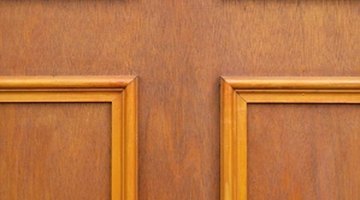How to Remove Tongue & Groove Paneling

Tongue and groove paneling is different from sheet paneling. The wood of the panel is often thicker and each plank is joined to the next through a tongue and groove. Often these planks are individually nailed to the wall and sometimes they are glued as well. Removing this type of paneling sometimes damages the wall behind it so badly that it is easier to replace the wall surface than to patch it.
-
Cut any caulk along the top and bottom edge of the baseboard with a utility knife. Slide a 4-inch putty knife between the baseboard and the paneling. Use the putty knife to shield the paneling from dents. Slide your pry bar or crow bar between the putty knife and the baseboard and pry the baseboard loose and remove.
-
Remove upper moldings such as crown or corner moldings the same way. Often the wood used in this type of paneling is good quality and many woodworkers try to save as much of the wood as they can for future projects.
-
Wear safety goggles. Adjust the depth of your circular saw blade so that it will just cut through the depth of the paneling. Be aware that your saw may kick back hidden nails, so try not to stand directly behind the castoff of the blade. Make a cut from the top of the board to the bottom. Your saw will probably not reach the edge of the board and you will have to chisel out the top and bottom to loosen your first board.
-
Pry the first board loose and examine it to see how it was installed. Often a single worker will install such walls and will follow the same procedures for most boards. This may help you find nails, glue and other obstacles. When possible, if the underlying wall is in reasonable condition, shield pressure on the drywall or plaster by using a wide putty knife as you use your prybar.
-
Consider using a nail punch to drive finish nails through the tongue. This may allow you to remove the boards intact. The nails can be pulled from the wall later.
- Utility knife
- 4-inch wide putty knife
- Pry bar
- Crow bar
- Goggles
- Circular saw
- Wood chisel
- Hammer
- Nail punch
Things You Will Need
Tip
Glued boards may tear off the paper covering the drywall. The underlying wall may require significant repair or replacement.
References
Writer Bio
F.R.R. Mallory has been published since 1996, writing books, short stories, articles and essays. She has worked as an architect, restored cars, designed clothing, renovated homes and makes crafts. She is a graduate of the University of California at Berkeley with bachelor's degrees in psychology and English. Her fiction short story "Black Ice" recently won a National Space Society contest.
Photo Credits
- door panel cross image by PeteG from Fotolia.com
- door panel cross image by PeteG from Fotolia.com
More Articles



